Possibly, but I doubt if it drops enough to be measured by touch with the stat fully open. However, with the Bongo, if the stat is barely open, the coolant will be cooled more, as there is hardly any flow through the rad. Certainly with all the other cars I've had, the top and bottom hoses have both felt ruddy hotwiddowson2008 wrote:Ahhhhhhhh - penny drops
However, I think the stat does open (mine does anyway cos I can see it on the TM-2) but only a very small amount, allowing a trickle through the rad. So going back to Mels point, he is probably right.
Personally, I don't think you are going to get the bottom hose more than luke warm cos if the rads doing its job properly then by the time coolant gets to the bottom, it will (should) have lost most of its heat don't you think?
Design Fault
Moderators: Doone, westonwarrior
-
francophile1947
- Supreme Being
- Posts: 11354
- Joined: Mon Dec 18, 2006 6:15 pm
- Location: Norwich
Re: Design Fault
John
(Evidence that intelligent life exists in the universe, is that it hasn't tried to contact us)
(Evidence that intelligent life exists in the universe, is that it hasn't tried to contact us)
- The Great Pretender
- Supreme Being
- Posts: 2671
- Joined: Thu Oct 19, 2006 10:10 pm
- Location: Wigan
Re: Design Fault
No, I don't think a rad should do that.widdowson2008 wrote: Personally, I don't think you are going to get the bottom hose more than luke warm cos if the rads doing its job properly then by the time coolant gets to the bottom, it will (should) have lost most of its heat don't you think?
The system needs a return temperature that allows the outlet to be at the ideal working temperature not overcooled.
Temperature is not really relevant to the original question, flow through the rad is.
Would a cross flow rad offer a better long life option?
To infinity and beyond
- roofraisers
- Bongolier
- Posts: 175
- Joined: Sat Oct 03, 2009 9:24 pm
- Location: Carlisle
Re: Design Fault
Basic physics says, hot water will rise to the top of a body naturally & as the liqued cools & becomes more dense, it sinks under the effect of gravity (Convection, movement of molecules within liqueds & gases). In my life, I have generally found that gravity is a wonderful thing & should be used to at all times to assist in everything we do in our lives.If you try to fight gravity, you end up working inefficiently.The Great Pretender wrote:Why does the rad flow top to bottom as most of the time it isn't doing that?
Assuming the stat needs 96c to be fully open to allow the rad full flow, how often do you think a clean coolant system would reach that temp under normal running?
When an engine reaches 96*C, it doesn't mean that the radiator will suddenly go into full flow.
Mazda designed the Bongo to initally drive on the roads of Japan.The Japanese yearly temperature vary from -30*C in winter around Obihiro to +40*C around Tokyo.
The radiator has to be able to tranfer heat to the atmosphere during the high temperatures of summer. The radiators of vehicles that operate in hot climates tend to be larger than those that operate in colder climates because the heat tranfer is slower due to the difference in coolant temperature & the ambient air temperature being less.
The thermostat is designed to keep the engine at the optimum running temperature.When the coolant temperature rises above this, the thermostat opens & allows coolant to pass, at the same time cooler coolant from the radiator gets mixed in the engine by the water pump & begins circulating.This action will lower the engine temp & if it is less than the optimum running temperature, then the thermostat will close & allow now coolant to pass until the engine temperature has risen.
On a cold day in Obihiro the thermostat will spend very little time full open as the coolant returning to the engine could be -30*C (ambient air temp) & very little of this will be required by the water pump to mix in the engine for the operating temperature to fall. On the other hand, a hot day in Tokyo the thermostat will spend longer open, as the coolant returning to the engine will never get less than +40*C & a larger quantity will be required in the mix to achieve the temperature lowering.
You can demonstate this with some hot water in a sink. If you add a pint of water to it that has come from the fridge & then repeat with a pint of water that is at room temperature, which has the greatest cooling effect.... the stuff from the fridge naturally. This then shows us that to maintain a constant engine temperature, the flow through the radiator will be affected, slow flow at cold ambient air temperatures & fast flow at hot air ambient tempertures.
The radiator is a heat exchanger. It's purpose is to remove heat from the engine coolant to the outside ambient air temperature as efficiently as possible. As stated above,in a cold climate you would get away with a smaller sized radaitor on a Bongo than you would in a hot climate.The Great Pretender wrote:No, I don't think a rad should do that.widdowson2008 wrote: Personally, I don't think you are going to get the bottom hose more than luke warm cos if the rads doing its job properly then by the time coolant gets to the bottom, it will (should) have lost most of its heat don't you think?
The system needs a return temperature that allows the outlet to be at the ideal working temperature not overcooled.
Temperature is not really relevant to the original question, flow through the rad is.
Would a cross flow rad offer a better long life option?
The thermostats job is to regulate & maintain the engines optimum operating temperature, by constantly opening & closing, a lot or not alot, depending on the temperature of the coolant as it leaves the radiator & enters the engine via the waterpump.
Flow through the radiator is greatest when the ambient air temperature is at it's highest.
The build up of crude inside an engine to some extent in inevitable over time. This will always settle out of the coolant when it's moving at it's slowest speed. Gravity will always pull the particles to the lowest point & there they will rest & accumulate.
If you had a cross flow radiator, it would still gather sediment in the lowest part as gravity is still acting on the particles. I suppose you could design a catchment pit to collect sediment in the bottom of a radiator or move the outlet pipe up a few inches, but if it takes 15 years for sediment to accumulate, I think the outside of the radiator will require maintenance by then, in regards with loose & clogged fins, corrosion affecting the body etc. & so replacememt or overhaul is required anyhow.
Nigel.
- The Great Pretender
- Supreme Being
- Posts: 2671
- Joined: Thu Oct 19, 2006 10:10 pm
- Location: Wigan
Re: Design Fault
Thanks for the resume Nigel, can't say that I agree with all of it but that isn't what this topic was trying to expand on.
It would be nice to see a standard rad cut apart horizontal say 100mm above the base tank (now I wonder who could do that) Then further dissection to see if the cores blocked or the tank blocked first.
Then further dissection to see if the cores blocked or the tank blocked first.
Any topic about the cooling system tends to wander, what I'm trying to address is a known problem with a question regarding radiator design.
I take your point about a catchment pit but it isn't the outlet side that blocks as coolant appears to travel across the top tank then drops to the outlet due to little flow through the thermostat during normal UK running.
It would be nice to see a standard rad cut apart horizontal say 100mm above the base tank (now I wonder who could do that)
Any topic about the cooling system tends to wander, what I'm trying to address is a known problem with a question regarding radiator design.
I take your point about a catchment pit but it isn't the outlet side that blocks as coolant appears to travel across the top tank then drops to the outlet due to little flow through the thermostat during normal UK running.
To infinity and beyond
- Northern Bongolow
- Supreme Being
- Posts: 7722
- Joined: Mon Mar 15, 2010 11:33 pm
- Location: AKA Vanessa
Re: Design Fault
The Great Pretender wrote:Thanks for the resume Nigel, can't say that I agree with all of it but that isn't what this topic was trying to expand on.
It would be nice to see a standard rad cut apart horizontal say 100mm above the base tank (now I wonder who could do that)Then further dissection to see if the cores blocked or the tank blocked first.
Any topic about the cooling system tends to wander, what I'm trying to address is a known problem with a question regarding radiator design.
I take your point about a catchment pit but it isn't the outlet side that blocks as coolant appears to travel across the top tank then drops to the outlet due to little flow through the thermostat during normal UK running.
- The Great Pretender
- Supreme Being
- Posts: 2671
- Joined: Thu Oct 19, 2006 10:10 pm
- Location: Wigan
Re: Design Fault
Your reply is pervasive............Northern Bongolow wrote: i might have a rad in my shed that has already been looked into.
.
To infinity and beyond
- Northern Bongolow
- Supreme Being
- Posts: 7722
- Joined: Mon Mar 15, 2010 11:33 pm
- Location: AKA Vanessa
Re: Design Fault
i have  .
.
it came off kirstys motor some time ago.
it weighed a ton, and was full of brown flakey particles, so me being a tight arse i thought i would try to clean it out and keep it for an emergency spare.
so i mixed up a solution of household caustic soda crystals and water,and poured it into the plugged up rad. lots of the crud came out. so me being me repeated the proccess, then the phone rang-----------as it was soaking.---------how was i supposed to know caustic attacks ally

 .
.
result, one leaking cored rad.
so i took the tank off, top and bottom, and examined the oil cooler, only to find lots of crud still in the rad.
im affraid i cannot tell you where the crud was worse as i had dislodged most of it in the proccess.
parts available to view though if you are passing.
gives off hydrogen flamable gas aparantly too
it came off kirstys motor some time ago.
it weighed a ton, and was full of brown flakey particles, so me being a tight arse i thought i would try to clean it out and keep it for an emergency spare.
so i mixed up a solution of household caustic soda crystals and water,and poured it into the plugged up rad. lots of the crud came out. so me being me repeated the proccess, then the phone rang-----------as it was soaking.---------how was i supposed to know caustic attacks ally
result, one leaking cored rad.
so i took the tank off, top and bottom, and examined the oil cooler, only to find lots of crud still in the rad.
im affraid i cannot tell you where the crud was worse as i had dislodged most of it in the proccess.
parts available to view though if you are passing.
gives off hydrogen flamable gas aparantly too
- widdowson2008
- Supreme Being
- Posts: 1703
- Joined: Tue Nov 18, 2008 10:15 pm
- Location: N.E.Derbyshire
Re: Design Fault
Ady
I think these are the pics you took of the rad you 'cleaned' (in no particular order - sorry)
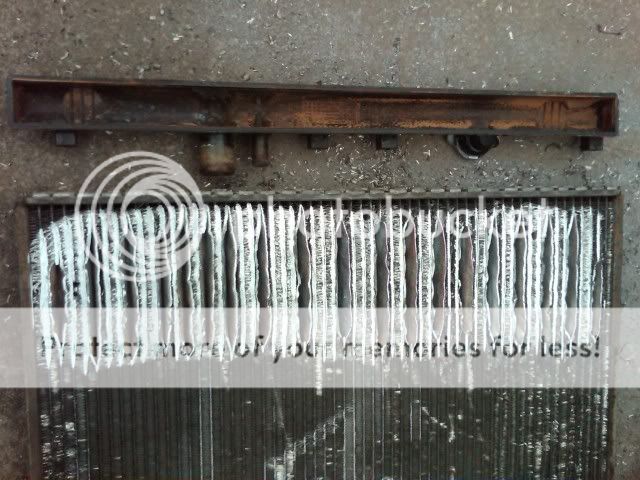


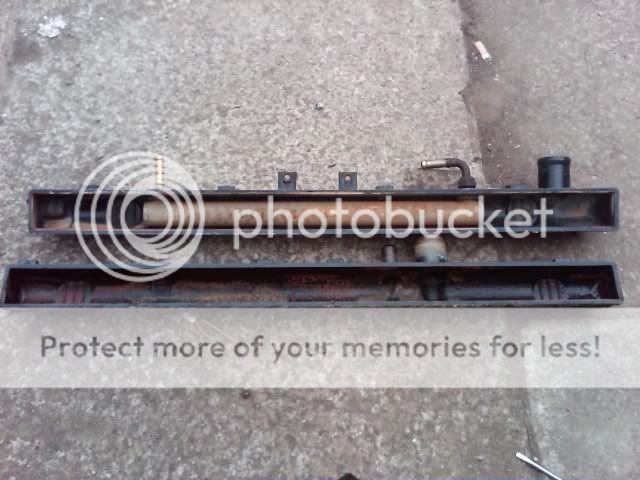
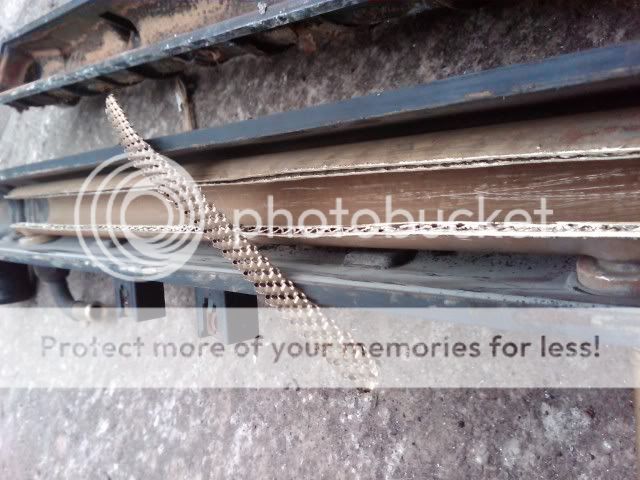



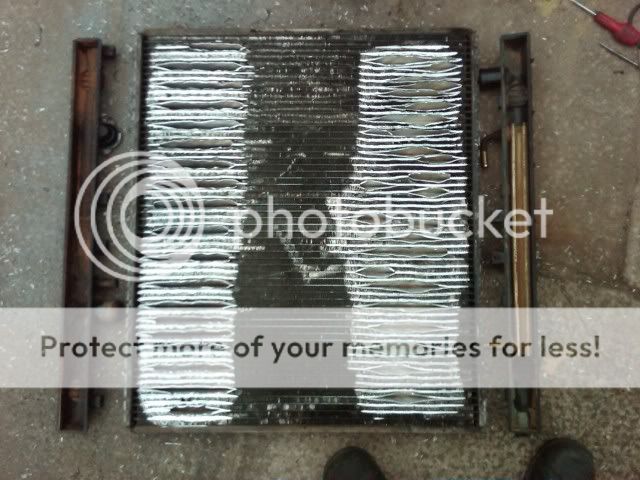
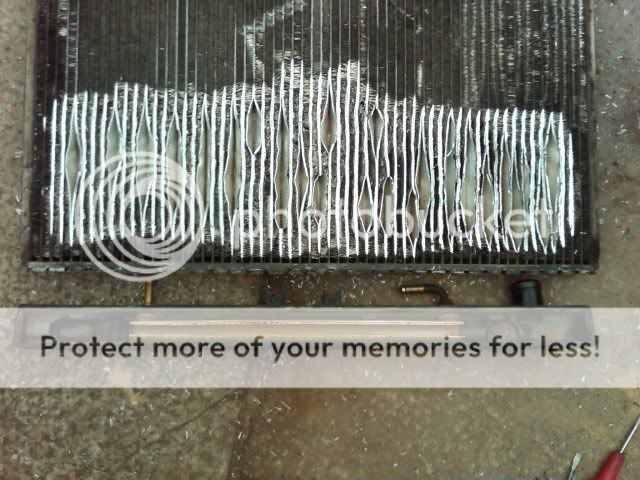
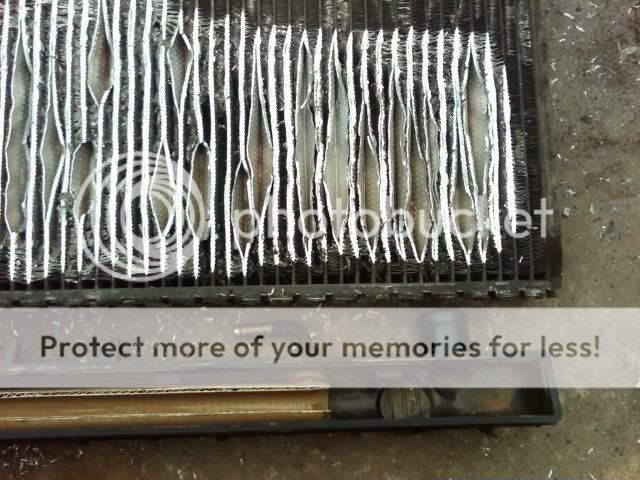

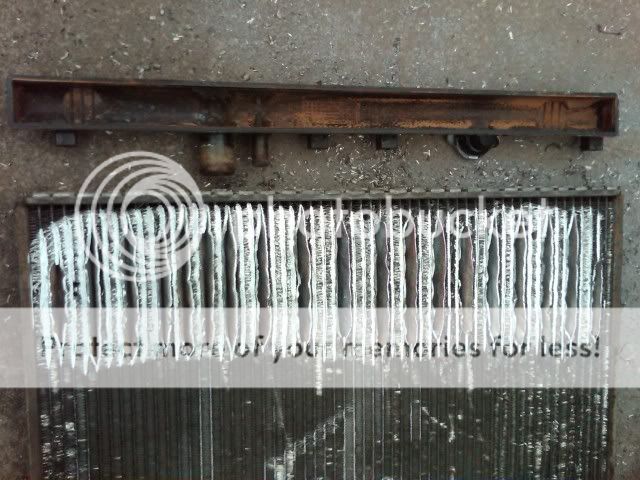
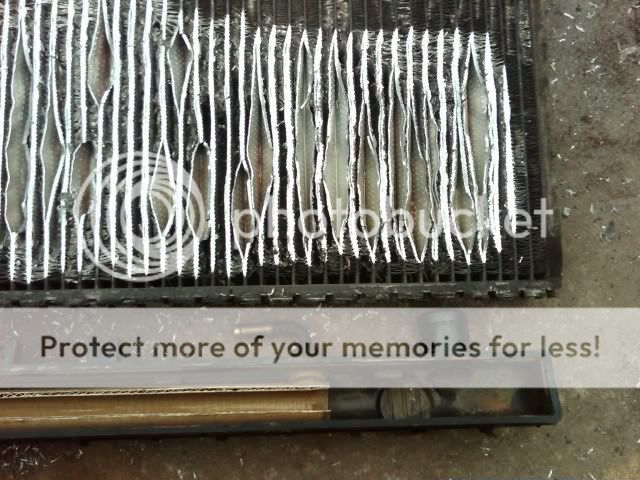
I think these are the pics you took of the rad you 'cleaned' (in no particular order - sorry)














Steve
Re: Design Fault
Very interesting to see the construction of the ATF cooler there. When I changed my fluid a while ago, it took a serious amount of blowing to get it to flow through. About 30psi on the air line. I was a bit concerned about it being fragile, but it looks reasonably sturdy when you see it dissected.
- roofraisers
- Bongolier
- Posts: 175
- Joined: Sat Oct 03, 2009 9:24 pm
- Location: Carlisle
Re: Design Fault
Sediment in the coolant can be arise from lots of different things.
No anti-freeze mixed with water will cause rust particles, mixing of incompatable anti-freezes can make strong acid/alkaline solutions & as coolant ages it breaks down naturally, becoming again, more acidic which attacks the innards of your engine & hoses resulting in dissolved particles being suspended in the coolant.
Once particles are in the coolant, they are going to try & settle some where within the engine cooling system.
As I said before, this will occur where the coolants flow is slowest or where there are "dead" areas of flow, in tank corners for instance.They generally accumulate in the radiator as it has the slowest flow but also the thinest tubes & things snag easily, then buildup causing a blockage.
Sediment can also build up in the lower part of the engine block because the coolant flow, even with the aid of a high speed water pump, is not enough to keep large particles suspended as they travel out via the thermostat.This build up will start at the farthest point from the water pump (where the flow is lowest) & then accumulate out/build up like a snow drift would.
What I'm saying is, coolant flow does not cause sediment to appear in your engine coolant system.
Once sediment is in your system you have to physically remove it.
Coolant flow will only move the sediment around your system & then dump it at the points where gravity has it's greastest effect or where a narrowing will cause an obstruction & then a build up.
If in your argument,particles were continually suspended in the coolant, this would lead to an abrasive liquid going around the cooling system causing damage to water pump bearings, aluminium heads, heater hoses, well just about everything.... which then results in a component failure & then the engine overheats.
Either way, a component will fail because of engine coolant sediment build up.... it just depends which one you want to chose.
Nice pics. of the radiator by the way, was there any crud still up the tubes?
Nigel
No anti-freeze mixed with water will cause rust particles, mixing of incompatable anti-freezes can make strong acid/alkaline solutions & as coolant ages it breaks down naturally, becoming again, more acidic which attacks the innards of your engine & hoses resulting in dissolved particles being suspended in the coolant.
Once particles are in the coolant, they are going to try & settle some where within the engine cooling system.
As I said before, this will occur where the coolants flow is slowest or where there are "dead" areas of flow, in tank corners for instance.They generally accumulate in the radiator as it has the slowest flow but also the thinest tubes & things snag easily, then buildup causing a blockage.
Sediment can also build up in the lower part of the engine block because the coolant flow, even with the aid of a high speed water pump, is not enough to keep large particles suspended as they travel out via the thermostat.This build up will start at the farthest point from the water pump (where the flow is lowest) & then accumulate out/build up like a snow drift would.
What I'm saying is, coolant flow does not cause sediment to appear in your engine coolant system.
Once sediment is in your system you have to physically remove it.
Coolant flow will only move the sediment around your system & then dump it at the points where gravity has it's greastest effect or where a narrowing will cause an obstruction & then a build up.
If in your argument,particles were continually suspended in the coolant, this would lead to an abrasive liquid going around the cooling system causing damage to water pump bearings, aluminium heads, heater hoses, well just about everything.... which then results in a component failure & then the engine overheats.
Either way, a component will fail because of engine coolant sediment build up.... it just depends which one you want to chose.
Nice pics. of the radiator by the way, was there any crud still up the tubes?
Nigel
- The Great Pretender
- Supreme Being
- Posts: 2671
- Joined: Thu Oct 19, 2006 10:10 pm
- Location: Wigan
- The Great Pretender
- Supreme Being
- Posts: 2671
- Joined: Thu Oct 19, 2006 10:10 pm
- Location: Wigan
Re: Design Fault
How about a crossflow rad with the engine flow and return connections at the bottom, that maybe would offer a solution to the known problem? 
To infinity and beyond
- widdowson2008
- Supreme Being
- Posts: 1703
- Joined: Tue Nov 18, 2008 10:15 pm
- Location: N.E.Derbyshire
Re: Design Fault
[quote="The Great Pretender" How about a crossflow rad with the engine flow and return connections at the bottom, that maybe would offer a solution to the known problem? :wink[/quote]
I know I'n not in your league when it comes to matters motor, and I'm quite slow on the uptake, so forgive me when I ask, what known problem? I can't see one. For me, something that lasts in excess of 10 years, and sometimes more, (with the correct maintenance) doesn't have a problem does it?
I can't see any errors in design. The system does what it does very efficiently............providing it gets the maintenance. Doesn't it?
I know I'n not in your league when it comes to matters motor, and I'm quite slow on the uptake, so forgive me when I ask, what known problem? I can't see one. For me, something that lasts in excess of 10 years, and sometimes more, (with the correct maintenance) doesn't have a problem does it?
I can't see any errors in design. The system does what it does very efficiently............providing it gets the maintenance. Doesn't it?
Steve
- The Great Pretender
- Supreme Being
- Posts: 2671
- Joined: Thu Oct 19, 2006 10:10 pm
- Location: Wigan
Re: Design Fault
I know I'n not in your league when it comes to matters motor, and I'm quite slow on the uptake, so forgive me when I ask, what known problem? I can't see one. For me, something that lasts in excess of 10 years, and sometimes more, (with the correct maintenance) doesn't have a problem does it?widdowson2008 wrote:[quote="The Great Pretender" How about a crossflow rad with the engine flow and return connections at the bottom, that maybe would offer a solution to the known problem? :wink
I can't see any errors in design. The system does what it does very efficiently............providing it gets the maintenance. Doesn't it?[/quote]
The league is irelivent, questioning is relivent.
What I'm trying to get to is the fact that the efficiency of the system negates the full use of the radiator for usual use.
Am I banging my head against a brick wall with this topic? Aint blocked rads a problem with Bongo's?
If you think a 10 yr life is ok that's fine, manufactures are more than happy with that.
I prefer to keep older vehicles on the road and it is only by looking at the problems that stopped them running we can keep them running.
To infinity and beyond
- widdowson2008
- Supreme Being
- Posts: 1703
- Joined: Tue Nov 18, 2008 10:15 pm
- Location: N.E.Derbyshire
Re: Design Fault
There may be another way - maintain them properly.
I can see what you are getting at though. Like you, I don't think the rad is worked very hard at all. Would there be a way to pump the coolant around the rad when the stat is closed?
I can see what you are getting at though. Like you, I don't think the rad is worked very hard at all. Would there be a way to pump the coolant around the rad when the stat is closed?
Steve






